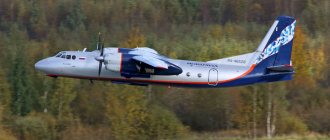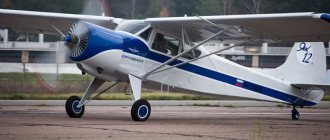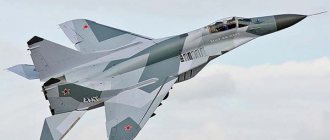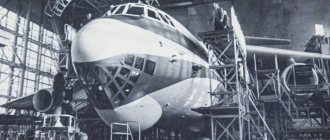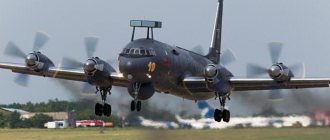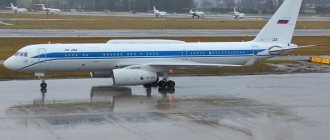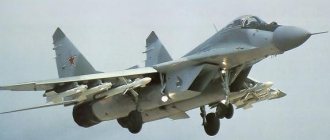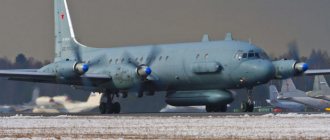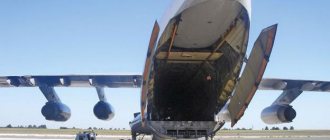Back in 1953, the government of the Soviet Union entrusted employees of the Tupolev design bureau with a responsible task. The essence of the new work was to create a new passenger airliner. It was from this event that the history of the creation of the legendary Tu-104 began.
It was not in vain that the choice fell on this design bureau, because this Soviet aircraft manufacturer a little earlier managed to successfully complete the construction of the Tu-16 missile-carrying bomber, the flight characteristics of which were noted by many world aircraft manufacturers.
Airplane Tu-104
Start of the project
The Soviet aircraft developer decided not to create a new project for the future airliner, but to construct a Tu-104 passenger aircraft based on a previously used project used for the production of a bomber. Considering that this solution helped the designers save a lot of time, the first project on paper was presented by engineers literally a year later. The Ministry of the Soviet Union studied and approved the draft version. The approval received allowed the design bureau employees to begin developing the first Soviet airliner, the Tu-104, in the summer of 1954 .
According to the initial project, the designers were supposed to equip the passenger jet airliner with two power units developed at the Mikulin Design Bureau - AM 3M 500. Taking into account the technical characteristics included in the project by the engineers, the future airliner had to accommodate at least 50 passengers, the airliner could lift into the sky a cargo weighing up to 1200 kg, and the maximum speed limit of the aircraft should reach 1000 km/h.
Of course, the design engineers did not borrow all the components from the prototype. The following elements were manufactured exactly as originals to equip the passenger airliner:
- cockpit;
- power unit nacelles;
- tail unit;
- wing and landing gear.
It was also decided to equip the air transport with flight and navigation equipment similar to the bomber, without the use of military devices.
The Tu-104 aircraft was also equipped with a completely new layout, in particular we are talking about a more spacious fuselage and an air intake for power units.
The best employees of the design bureau took part in the design process. A very fast pace was chosen for the work, which helped aircraft manufacturers at the end of 1954 of the last century to present a finished project for evaluation and approval. After reviewing the results of the work, representatives of the state commission approved and approved the model of the future passenger airliner presented by the engineers.
Unfortunately, over the years, the appearance of the domestic model has changed beyond recognition - due to low-quality mold material and unskilled repairs - but initially the Moscow Tu-104 and the TU-104 from the GDR were similar “right down to the scratches”. But there were also differences.
First of all, this concerned the breakdown of models into parts. In the German “TU-104” the “wing-center section-engine nacelles” unit was an assembly of two large parts (upper and lower halves). At the Moscow plant, probably to reduce the size of the mold, the wing consoles were separated from the center section, thus turning two parts into six. True, the craftsmen either did not know the term “center section” for toy making, or considered it too specific for children, and in the assembly instructions they dubbed this unit a “body” (much later, already at the Krugozor plant in the late 1980s, list details in the instructions were edited and the parts were named correctly).
The instructions themselves were originally a booklet that included the main technical characteristics of the aircraft and the actual assembly instructions. At the same time, the type of aircraft was designated as “Tu-104B”, and the data of this particular modification are given, although the model itself in geometry represented the original Tu-104 or Tu-104A.
Both manufacturers initially tried to make the color design of the sets as close as possible to the prototype. Thus, for the German model, the fuselage halves were cast from white plastic, and their lower part was painted directly at the factory with aluminum paint from an airbrush. The parts of the wings, engines, tail surfaces, struts and landing gear doors were also painted (the color of the plastic from which these parts were cast was arbitrary: most often black or gray-green with streaks). The wheels were made of black plastic. In the Soviet model, those parts that were supposed to have an aluminum color were initially directly cast from silver plastic. The fuselage, like that of the “German,” was white (often a yellowish or “marble” hue), and paragraph 12 of the instructions ordered its lower part to be “painted in the color of the aircraft’s wings” (later in the GDR they also refused to paint parts at the enterprise and steel include a container with “silver” in model kits, but in all likelihood there were no paints in Soviet kits). The wheels of the Soviet model were also black. In addition to the parts of the aircraft itself, the kit included a two-part stand (a rectangular base with a “wing-shaped” profile with a relief Aeroflot emblem and a high curved leg). In the lower half of the center section there was a rectangular hole for a stand. The German “TU-104”, as well as other early “KVZ” models, did not have a stand.
Transparent parts in both models were available only for the glazing of the pilot's and navigational cabins. The Germans proposed to “glaze” the windows of the passenger compartment from the inside with the thin polystyrene film included in the kit. In the Soviet set there was no such “luxury” - the windows remained empty holes. The number and location of windows generally corresponded to early modifications (basic Tu-104 and “A”), but there were some inaccuracies. In particular, in the 2nd place in front on the starboard side there were 2 windows, one above the other - the bottom one was superfluous. But there were no “ceiling” windows at all: three windows on the left side above the center section (where the kitchen was located on early Tu-104s) and a small window in the nose fairing above the navigator’s workplace. Most likely, their absence was forced - due to technological limitations of casting, because they would be located practically across the plane of the mold parting. For the same reason, all the windows located above the main row turned out not to be round, but “egg-shaped”.
Characteristic parts of both models were simulators of engine inlet devices in the form of cones installed in the air intakes of engine nacelles. In reality, these devices had a completely different design and were located much deeper in the engine nacelles, in the area of the rear wing spar.
The chassis of both models was made in a minimalist style. The doors were depicted as rough U-shaped parts glued to the fuselage and gondolas, the niches were completely absent, as was the tail heel, and the nose and main struts resembled concrete pillars in their detailing. All this was fully justified by the fact that the models were developed primarily as toys, which means that simplicity and reliability came first, not replicas.
The wheels also looked primitive (later on the German model they were replaced with more detailed and reliable sizes). Moscow model makers not only did not bother themselves with such a “modernization”, but also “saved” by equipping the Il-18 model with the same “chassis”, which was also a “twin” of the corresponding “KVZ” product, but the German “IL- The 18” chassis parts were our own. The struts from the Tu-104 were clearly too high for the Il.
The decals included in the kits of the Soviet and German models were very similar in design of the main elements. But if the decal from the German kit contained the real tail number USSR-L5400, corresponding to the prototype of the aircraft, then the “transfers” of the Moscow kit offered the abstract number USSR-4242. True, there was still some truth in this “binary code” - according to the numbering system introduced in civil aviation of the USSR in 1958, the tail numbers of Tu-104 type aircraft began with the number 42, but were not 4, but 5 digits . In addition, the oblique font of the wing numbers actually took place on only one aircraft - the mentioned USSR-L5400; on all subsequent aircraft, the wing numbers were applied in a rectangular font. In addition, the Soviet decal did not contain a cheatline (side strip with a “zipper”), but the most exotic feature of domestic decal printing was that the decal elements were printed on opaque yellow plates and applied to the paper base with the reverse side up. The instructions recommended gluing them to the model with office glue.
In early releases, the model from MZMPI was packaged in a nice blue-yellow box, on the front side of which a flying Tu-104 was depicted from the starboard side against a blue sky with white “cloud swirls”, accompanied by a pair of small airplanes on a parallel course in the upper left corner. The design of the box art expectedly resembled the first edition of the box of the German analogue, only it was made in yellow-green tones, the plane was flying in the other direction and not against the sky, but over fields and forests. Even the font of the name “TU-104” in the Soviet picture resembled the font of the inscription “TU-104” on the “KVZ” box. In general, despite a number of “nuances”, the model of the first Soviet jet airliner from Moscow at the time of its appearance. Alas, this did not last long...
In the early 1970s. The MZMPI plant received a more euphonious name “Young Technician” . The changes also affected the presentation of manufactured products. Unfortunately, most of them can hardly be called positive. To begin with, the Tu-104 model has a radically simplified box design. Not only the “excesses” such as “swirling clouds” and small airplanes disappeared from the front picture, but also the name of the model itself, which remained only on the ends of the box. On the other hand, the castings were no longer placed directly in the box, but in a sealed plastic bag, which reduced the risk of damage and loss of parts during transportation. (Before this, large parts “dangled” freely in the box, and wheels and other “trifles” were packed in a paper bag with a stamped model name).
The content also did not escape “adjustment”. The design of the stand has changed - now it was memorable for modellers of the 1970-1980s. an elongated, rough rectangle with a low, straightened leg. In the production of the model itself, multi-colored plastic was abandoned - the airframe parts became the same color (white or gray), only the wheels were still cast in black for some time. But the main thing is that the molds underwent repairs, which resulted in a change in the geometry of the model. The shape of the bow became blurry - the kink between the windshield of the pilot's cabin and the nose and the characteristic "bump" of the weather radar fairing at the bottom disappeared. The wing also lost the characteristic kink of the leading edge - it became straight along the entire span. The internal markings of the doors and steering surfaces were replaced with external ones. They began to “spread” in the diameter of the porthole openings.
Despite these “alarming symptoms,” it was during this period that the models of the Soviet manufacturer had the opportunity to compete with their counterparts from the GDR “on enemy territory.” In the 1970s, the DIWI was engaged in the import of Soviet fashion products, incl. products of “Young Technician”. The company printed its own boxes and rotaprinted duplicates of instructions in German, but otherwise the contents of the sets were Soviet. The box depicted a Tu-104 against the backdrop of a sunset sky, in a very fancy livery (more reminiscent of the livery of Aeroflot’s Tu-124s) and with the abstract number USSR-14250, which had never been used on aircraft of this type. However, “DIWI”, as already mentioned, did not have its own decals.
In the second half of the 1970s. the production of prefabricated models moved from Young Technician to the new Krugozor . The change of production site also entailed new changes in the appearance of the products. Partly they were positive - the name of the aircraft was returned to the front side of the box of the Tu-104 model, and in triplicate (in a column, in an increasing font). The old instructions in the form of a booklet were replaced by a sheet with an assembly diagram in pictures - to unify the design with the models of the “Novo” series, which then began to be produced at the plant in parallel with the domestic line. In the title text of the instructions, some errors were corrected over time - the letter “B” was removed from the name of the aircraft (although the technical data provided still corresponded to this modification), and the names of the parts in the list became more technically correct. Instead of old glass vials, the glue included in the kit began to be poured into polyethylene cylindrical jars with a “pipe” on the lid, which was a definite plus (glass containers often broke during transportation, spoiling model parts with spilled glue).
The models themselves began to be cast from polystyrene only in white, without “excesses” in the form of black chassis parts; only the stand differed in color. After the move, the molds underwent another “repair”, alas, which again did not have the best effect on the quality of the model. The porthole openings not only increased in size even more, but also began to “dance” in height. In the second place on the starboard side, where there was a vertical pair of windows, the “extra” was removed, but not the upper one, leaving the lower one, although in fact the opposite was required. For some reason, the raised pair of windows on the starboard side above the center section moved to the place in front of the pair of the main row. In addition, the middle part of the fuselage lost its cylindricity, swelling in width. The thickness of the landing gear struts was reduced, but this did not add to their replica quality at all, only reducing their strength. The wheels are also thinner. To top it off, the fit of the main parts of the model has sharply deteriorated.
However, Soviet pioneers and schoolchildren no longer had a choice - in the mid-1970s. The German “TU-104” was discontinued. However, even before that, for many young aviators (or rather, their parents), the decisive factor was the price - 80 kopecks against a two-ruble imported “luxury”.
The production of the “Prefabricated model of the Tu-104 aircraft” at the Krugozor plant continued until the early 1990s. , after which the model disappeared from sale for 10 years.
In the “dashing 90s,” the Moscow enterprise was going through hard times, periodically teetering on the brink of bankruptcy. The first alarming symptom was noted in 1987-1989, when several directors changed at the plant. The situation was stabilized after the appointment of A.M. Sherstenikov to this position, but in 1990-1991. Cooperation with specialists from the former GDR had to be curtailed, which led to the cessation of machine maintenance on their part. Even under the USSR, the plant was transferred from a state enterprise to a leased one, and in 1992, to a closed joint-stock company, becoming the property of the team.
A global collapse occurred in 1992-1993, when the Roskulttorg system collapsed, whose wholesale bases were the main buyers of Krugozor products. However, thanks to the efforts of the management, it was possible to arrange supplies to the Detsky Mir chain of stores and in 2003 even reach production profitability, but everything was in vain...
The company's shares gradually passed to a new owner - the Horus Capital company. In 2006, the board decided to build an office center on the plant’s premises, which automatically meant its liquidation.
In the early 2000s. The Tu-104 model, along with a number of others, returned to store shelves for a short time. At this time, “Krugozor” made a radical update of its “image” - new “universal” boxes appeared, on which the entire line of manufactured products was depicted in small drawings. The contents of a particular box were marked with a sticker pasted into an empty box with the model name on the side of the box. The old “decals” have been replaced with nicer sticky appliqués on mylar film. True, the tail number USSR-42501, proposed in the new design of the model, in reality belonged to the aircraft of the “B” modification. This airliner (serial number 021804) was produced by the Kazan Aviation Plant on October 26, 1960, was initially operated in the Ukrainian State Administration (Kyiv-Boryspil), and in 1973 was transferred to the Far Eastern Administration (Khabarovsk-Novy). On November 5, 1974, the plane suffered an accident in Chita (rolling off the runway during landing due to a crew error), after which it was written off on November 28, 1974.
The castings of the model itself did not change at all - it seemed that it was simply impossible to further disfigure the mold... Not surprisingly, low-quality products were no longer in demand among modellers, and soon the Krugozor plant completely stopped production, and then was completely closed.
The last chapter in the history of the TU-104 model took place in the second half of the 2000s. After lying in storage for a long time, production equipment for the Tu-104, Il-18 and Il-62 airliner models was purchased from Krugozor and ended up in the possession of the Alanger . The Russian manufacturer has decided to release a “vintage” series of models, but with an updated design. The molds for the Tu-104 and Il-18 were once again repaired. The announcement of “vintage” took place in December 2005. Here is a statement on this matter published by the Alanger company itself:
“These are old molds, but we removed the “wild holes” that were there instead of windows and everything connected to the chassis. The gliders themselves were polished and it turned out quite well.”
In reality, the “repair” essentially consisted only of sealing the portholes. The landing gear in the Il-18 kit remained, but on the Tu-104 they were actually “removed”, and in a very non-trivial way - in order not to bother filling up the holes for the struts in the lower wing panels, the Alangerites replaced them in the kit... with a second pair of upper ones, not at all without being embarrassed by the presence of aerodynamic ridges on them, which should not be on the lower surface of the wing. At this point, the process of “bringing it to mind” was considered completed.
But the updated kits included amazing decals from the Begemot company, which printed a full livery with images of portholes. True, there were some mistakes here too - the line of windows on the decal corresponded to the modification of the Tu-104B (as the model was once called in the instructions), but the model itself had a shorter fuselage of earlier modifications, so the front entrance door was on the left side and the first window was on the right turned out to be too close to the nose. At the same time, the tail number USSR-42385 corresponded to a real aircraft of modification “A”. This airliner (serial number 8350605) was produced at plant No. 135 (in Kharkov) on August 30, 1958 and was handed over to the Moscow Transport Administration on September 6. Civil registration was received on November 11, after the aircraft was accepted into the Vnukovo OJSC. In its original form, the aircraft flew for about a year and a half, until in August 1962 it was upgraded to the level of the Tu-104B. Subsequently, the USSR-42385 board was successively transferred to the Northern CAA (04/07/1967, Pulkovo OJSC) and the East Siberian CAA (05/07/1977, Irkutsk OAO), after which it was decommissioned on October 25, 1978 due to the completion of the overhaul period resource.
The updated model appeared on wide sale in 2006 under the box name “Airliner Tu-104” and internal index 050003, but it did not stay on store shelves for long. Having found itself in a difficult financial situation, the Alanger company was declared bankrupt, and the molds belonging to it were arrested and taken for storage. Now their fate is unknown, but, according to unconfirmed reports, part of the production equipment was scrapped.
Currently, Tu-104 models from Krugozor and KVZ (better known now as VEB Plasticart) can only be found at online auctions for very decent money. Analogues in 1/100 scale never appeared, however, in the late 90s, the new company OKB-144 (a subsidiary of the Ukrainian enterprise YUMTK) released the Tu-104A model in the fashionable scale of 1/144 (which was reflected in the company name). The model was made using LND technology and did not “shine” with high quality, although its geometry was still better than that of the Krugozora product. Models in the same scale from other manufacturers followed. New Moscow companies “RusAir” and “AWM” each produced a pair of “one hundred fours” (modifications A and B) using the polyurethane resin casting technique. And in the 2010s. The Ukrainian company “A-Model” has released a whole series of plastic models of the Tu-104A in 1/144 scale, differing only in the box and decal design.
And finally, the Czech company HPH has pleased fans of “large forms” by releasing a superbly detailed 1/72 scale model of the Tu-104A, made of resin and fiberglass.
“Assembled model of the Tu-104 aircraft” - a box for a model produced by MZMPI, 1960s.
“Cons” and some features of the new model
Unfortunately, experts also noted several negative aspects regarding the jet passenger airliner:
- Insufficient comfort for those on board. This is clearly visible in the photo of the Tu-104 interior. This inconvenience was especially pronounced at altitudes exceeding 10,000 meters, as soon as the pressure reached 0.45 atmospheres. In order to protect passengers, it was decided to make certain changes to the design of the airliner, in particular, to install a sealed partition between the cockpit and the passenger compartment. A photo of the Tu-104 aircraft will help you visually familiarize yourself with the changes made.
- The expert commission also noted that if air transport is too overloaded, then if one of the engines fails, the plane will not be able to continue flying.
- In turn, the pilots also noted some omissions, in particular, they were talking about the difficult piloting of air transport at an altitude exceeding 10,000 meters. Design engineers who analyzed the shortcomings noted by the crew again had to make changes to the design of the airliner. First of all, it was decided to reduce the angle of the previously installed stabilizer, which in turn helped to expand the range required by pilots at the moment of deflection of the steering wheel. The attitude indicator was also replaced with a more sensitive and soft model used to equip military fighters.
The feat of Harold Kuznetsov
But, as we know, there are no revolutions without victims. Operation of the Tu-104 soon revealed serious shortcomings of the vehicle. The pilots noted that the airliner was unstable in flight, heavy, and prone to rocking—the so-called “Dutch step.”
But the most terrible phenomenon that the Tu-104 crews encountered was “catch.”
When “caught,” the aircraft is rapidly thrown up 1-2 km within a few seconds with a large increase in the angle of attack. Then the plane loses speed, falls into a dive and dies.
In the era of the appearance of the Tu-104, “pickup” was a practically unknown phenomenon. The experience of piston passenger aircraft flying at much lower altitudes could not help here.
On August 15, 1958, a regular Tu-104 crashed near Khabarovsk. 64 passengers and crew members were killed. The pilots insisted that something strange was happening to the plane. The designers, including Tupolev, objected - the problem was with pilots who could not control the aircraft.
The situation was changed by the crash of another Tu-104, which occurred on October 17, 1958 in Chuvashia, near the village of Kanash. Experienced ship commander Harold Kuznetsov , faced with a “catch,” fought to the last to save the vehicle, but was unable to prevent a disaster in which he and 79 other people died. However, the fact that Kuznetsov transmitted information to the ground about what was happening until the very end allowed the designers to understand the cause of the tragedy.
The Tu-104 fell into the very center of a vertical air flow 13 km long, 2 km wide and 6 km thick. The air speed in the flow was approaching 300 kilometers per hour. The designers of the first civilian jet ships simply did not know about the existence of such monsters at high altitudes, and therefore did not take them into account.
To combat such a threat, the Tu-104 lacked stability and elevators. The courage of Harold Kuznetsov and his crew members made it possible to understand all this.
Updated models
Design engineers continued to work on modernizing the passenger jet airliner. Thanks to the well-established work, at the beginning of 1957, an updated Tu-104A model was created with an increased passenger capacity of up to 70 people. Engineers also equipped the new model with a more powerful RD 3M power plant and new navigation devices.
About a year later, the developers presented another development, which was given the name Tu-104 B. The length of this model reached 40 meters, and up to 100 passengers could be accommodated on board. It was this model that was first decided to be equipped with a kitchen, allocating space for this room in the forward salon.
This model was not the last in a long list of passenger jet ships created by the hands of Soviet engineers. After all, almost every year talented designers presented updated versions of jet aircraft. Some projects were never approved due to the presence of numerous shortcomings, while others are currently being used for their intended purpose.
Checkmate, English gentlemen!
The experimental Tu-104 made its first flight on June 17, 1955.
At this time, work was already in full swing to prepare for mass production of airliners of this type. The first production Tu-104 of the so-called “zero” series took off on November 5, 1955, that is, less than six months after the flight of the first prototype.
State tests of the first prototype Tu-104 took place from January to June 1956. The new product was presented to Nikita Khrushchev , who, being very pleased with the new achievement of Soviet aircraft designers, decided to fly it on an official visit to London.
The specialists grabbed their heads - the machine was “crude”, not fully tested, and such a flight looked too dangerous. Reluctantly, Khrushchev abandoned his intentions, but nevertheless ordered the Tu-104 to be brought to the capital of Great Britain.
On March 22, 1956, the Tu-104 arrived in London without Khrushchev, but with a group of Soviet diplomats preparing Khrushchev's visit.
The appearance of the Tu-104 in the UK had the effect of a bomb exploding. The fact is that it was in Great Britain that the world's first commercial jet airliner, the Comet, began operation in January 1952.
But both British and Soviet aircraft manufacturers were still unaware of many of the pitfalls associated with the use of jet aircraft in civil aviation. A series of unexplained Komet disasters, the causes of which became clear much later, led to the decommissioning of this airliner. All the more unpleasant for the British was the appearance of the “Russian Comet”, which intercepted the laurels of the English plane.
Photo: Collage AiF
The fact that the Tu-104 also has serious flaws will become clear later. And then the Soviet Union enjoyed its victory over its Western competitors.
Touched to the quick, British journalists reported “sensational news”: the Russian Tu-104 exists in a single copy, and to enhance the impression, they repaint the side numbers to create the impression that there are many such machines.
Andrei Tupolev was offended by this, and he gave the command to send three Tu-104s to Britain at once, lining them up in a row at London airport. After this, even the most zealous skeptics capitulated, recognizing the success of the USSR.

